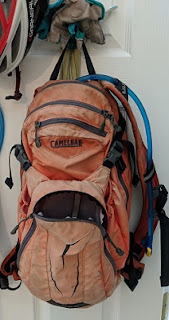CamelBak M.U.L.E Hydration Pack (100 ounce)
The exercise docs tell us that we should consume about 32 ounces of water per hour while performing endurance sports. I know, I just asked over at WebMD (a pretty trustworthy source, IYAM). As our longer rides crested three hours and headed for four, the 70-ounce CamelBak Rogue I’d used for several years was overmatched. One dare not suffer dehydration in the sweltering steam bath of a central Indiana summer day, so an alternative seemed in order. That alternative was a CamelBak M.U.L.E. (“M.U.L.E.” is a carefully contrived acronym), with its 100-ounce capacity. It’s more than a mere water bottle, howeverThe MULE’s designed with cyclists in mind, a low-profile pack that rests on the rider’s back out of the wind. Like all CamelBaks, there’s a polymer tube that routes from the water bladder over the shoulder to a bite valve near the cyclist’s “intake.” This pack is also designed as a sort of biker luggage, with storage galore and lots of comfort features.
The body of the pack rests against the wearer’s back on a set of cushioned standoffs intended to increase airflow between pack and body (it seems to work). The bladder fits into a zipper compartment accessed from the rear instead of the front or top, unlike conventional hydration packs. In my iteration of the MULE, the wide-mouth (3½ inch) bladder fill cap opens with a quarter turn (strengthen those fingers, potential users) and hooks onto a strap across the inner surface. The supply tube disconnects with a quick-release so the bladder can be lifted entirely out for filling. Before the full bladder (weighing 6-plus pounds) can be tucked back into its resting place, the hose has to be reinserted, and the “hook” inserted around the hose. It can be tricky when the bladder is full.
CamelBak put together an independent suspension harness system for the MULE, with broad, padded shoulder straps and a chest strap that slides through a length of about eight inches. There’s also a removable 1-inch waist belt for added stability. The water tube can be routed through a loop on either shoulder strap, ostensibly to keep the bite valve near the mouth (it doesn’t, unfortunately); the right-hand slider of the chest strap has a keeper hook for the tube. Expect a big bite valve for fast water delivery and a Hydrolock water shutoff valve, though the stock CamelBak tubing is rather short and has become rather stiff in recent versions.
CamelBak adds a small bit of security with reflective stripes on the two hose loops on the front and a narrow reflective strip across the light mount on the rear. The logos may also be reflective thread; it’s hard to tell. Don’t depend on these little strips to save your life at night, not with drunken drivers out there texting excuses about being late to their significant others after a post-work happy hour…
| I like that the pack is capacious and holds a three-hour supply of water, even though it weighs just 1.7 pounds (one pound, 11 ounces) empty. I like that the pockets are versatile and well-designed, and that there’s a chest strap to keep the pack from sliding off my shoulders whenever I lean down. I like that it’s tough 420-dernier nylon, DWR-coated (Durable Water Repellent) with quality zippers, straps and buckles. On the other hand, I think inserting a full bladder is a hassle, the supply tube is about six inches too short and the chest strap has to be all the way to the bottom to keep from strangling the wearer. You know what I think? I think it’s a good, comfortable, high-quality pack – but it could have been just a little bit better. |
Summary:
Plus: well-made, chest strap, large capacity, good storage, comfyMinus: bladder a beast to install, hose too short, chest strap rather high
What They're Saying: Dear CamelBak: Your M.U.L.E. is pretty darned good, but next time you decide to update the design give me a call: I have some suggestions.
copyright © 2018 scmrak


No comments:
Post a Comment